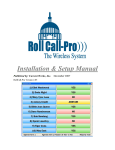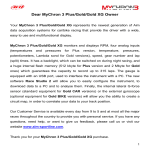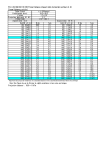Download EC900 Series Oxygen Analyzer User Manual
Transcript
Illinois instruments Illinois Instruments, Inc. SERIES 910 AND 930 OXYGEN MONITOR OPERATOR’S INSTRUCTION MANUAL CONTENTS Page 1. PREFACE 1 2. INTRODUCTION 2 3. WARRANTY 4 4. PRINCIPLE OF OPERATION 6 5. SPECIFICATION 7 6. INSTALLATION 8 7. USING THE INSTRUMENT 11 8. INSTRUMENT OPERATION 12 9. PROGRAMME CODES 17 10. CALIBRATION 19 11. RS 232/485 COMMS PORT 22 12. OPTIONAL FACILITIES 24 13. FAULT MESSAGES/ALARMS 25 14. REPLACING THE MEASURING CELL 26 15. SPARE PARTS 28 DRAWINGS: B 900 062 B 900 022 Illinois Instruments, Inc. Series 910 & 930 Instruction Manual 1. PREFACE The 900 series of oxygen monitors can exist in a number of standard variations and these are covered in this manual. The instrument has been designed in such a way that sub-variations to customers specific requirements may be provided. Where these have been included, this manual has been appended. We are always trying to improve our product, of which this manual is part and so we would greatly appreciate any information you can give us of any difficulties you may encounter with the monitor or the manual. IMPORTANT Please read this manual before attempting to install or operate the equipment. The equipment should be electrically connected and grounded in accordance with the instructions attached to the power cord and in accordance with good standard practice. In some variations, the instrument is provided with a dual voltage IEC inlet connector. Please refer to the Introduction and Installation sections of this manual. No responsibility is accepted by Illinois Instruments, Inc. for accidents resulting from improper use of this equipment. All service and technical enquiries are covered from our factory in Thame, Oxfordshire, where we will endeavour to give a quick and helpful response to all queries. The factory address details are: Illinois Instruments, Inc. 2401 Hiller Ridge Road Johnsburg, IL 60050 USA Tel: +815-344-6212 Tel: +815-344-6332 1 of 29 Version: 1.6 Instruction Manual Updated: 31/01/2002 Illinois Instruments, Inc. Series 910 & 930 Instruction Manual 2. INTRODUCTION The 900 Series of instruments may be supplied in three types of cabinet/housing and may use any one of four measuring cells, suitable for different applications. The instrument may also be fitted with other customer specified options. Please refer to Table 1 for the specification code. When particular attention should be given in this manual to a particular configuration the paragraph will be preceded with a configuration specification i.e. 91X = Panel/Bench mounting 9X1 = Trace analysis 2 of 29 Version: 1.6 Instruction Manual Updated: 31/01/2002 Illinois Instruments, Inc. Series 910 & 930 Instruction Manual TABLE 1 Series 900 Oxygen Analyzers ______________________________________________________ Cabinet - Mounting Panel or bench mounting Wall mounting IP66/Nema 4x Rack mounting (*Note 1) Configuration % analysis Trace analysis Ultra low trace analysis RACE ______________________________________________________ 9 1 2 3 0 1 2 3 * Note 1 Rack is 19" 4U high. The rack provides a housing for 1 or 2 analyzers. Please contact Illinois Instruments, Inc. for pricing for a 2 analyzer rack. 3 of 29 Version: 1.6 Instruction Manual Updated: 31/01/2002 Illinois Instruments, Inc. Series 910 & 930 Instruction Manual 3. WARRANTY Instrument The instrument is guaranteed for a period of one year from its delivery to the purchaser, covering faulty workmanship and replacement of defective parts. This assumes fair wear and tear and usage specified on the data sheet. It does not cover routine calibration and housekeeping. Illinois Instruments, Inc. are happy to quote for routine servicing of the equipment at the customer’s premises. We maintain comprehensive after sales facilities and the instrument should be returned to our factory for repairing or servicing if this is necessary. The type and serial number should always be quoted, together with full details of any fault. Warranty repair or replacement will be made without charge, noting the above comments. Equipment must be shipped prepaid after return authorisation has been obtained. Measuring Cells Important - See Note Below a) Percent Cells Percent cells have a warranty of 3 years form the date of supply. Cells measuring oxygen concentrations of less than 10% should have a lifetime of 5 years +. b) Trace Cells Standard trace cells have a warranty of six months from the date of supply. Cells measuring oxygen concentrations of less than 100ppm should have a lifetime of 4 years +. c) Ultra Low Trace Cells Ultra low cells have a warranty of six months from the date of supply. Cells measuring oxygen concentrations of less 10ppm should have a lifetime of 5 years +. d) Race™ Cells 4 of 29 Version: 1.6 Instruction Manual Updated: 31/01/2002 Illinois Instruments, Inc. Series 910 & 930 Instruction Manual Race cells have a 3 year limited warranty, that is if a cell should be returned after 2 years the customer will be credited with 33% of the cost of a new cell at the time of replacement. Race cells used on trace analysis should last 4 years +. NOTE Most cells that do not last their expected lifetime fail because:1. The isolation valves on the analyzer are left open, causing ingress of high ambient oxygen levels. 2. The cell has been ruptured caused by high pressure, either because the inlet valve has been opened before the outlet valve in presenting the sample gas to the analyzer or because the outlet valve has been closed first before the inlet valve. Ruptured cells can be confirmed by electrolyte solution seeping from the inlet/outlet pipes or by blackening of the same pipes. MISUSE OF THE CELL IS NOT COVERED BY WARRANTY 5 of 29 Version: 1.6 Instruction Manual Updated: 31/01/2002 Illinois Instruments, Inc. Series 910 & 930 Instruction Manual 4. PRINCIPLE OF OPERATION The detector contains an anode, electrolyte and an air cathode to which the diffusion of Oxygen is limited by a diffusion barrier. At the air cathode Oxygen is reduced to Hydroxyl ions which in turn oxidise the metal anode. The following reaction takes place at the cathode: O2 + 2H2O + 4e -> 4(OH)and at anode 2Pb + 4(OH)- -> 2Pb(OH)2 + 4e and the complete chemical reaction is represented by 2Pb + O2 + 2H2O -> 2Pb(OH)2 6 of 29 Version: 1.6 Instruction Manual Updated: 31/01/2002 Illinois Instruments, Inc. Series 910 & 930 Instruction Manual 5. SPECIFICATION RANGES: DISPLAY: RESPONSE TIME: ACCURACY: SUITABLE GASES: 9X0 0.01% - 100% Autoranging 9X1 0.1ppm - 30% Autoranging 9X2 0.01ppm - 30% Autoranging 9X3 0.1ppm - 30% Autoranging 4 Digit high visibility LED 9X0 90% indication in less than 30 seconds 9X1 90% indication in less than 30 seconds 9X2 90% indication in less than 30 seconds 9X3 Air to less than 20ppm in 2 minutes 9X0 0-20%, ± 0.05%, 0-100%, ± 0.1% 9X1 9X2 9X3 All gases except corrosive gases 9X0 9X1 ± 2% of reading 9X2 9X3 All gases except corrosive and/or acidic gases AMBIENT TEMPERATURE: -5°C to 50°C SAMPLE PRESSURE: 0.25 BAR - 2 BAR DIMENSIONS: Refer to the drawings at the rear of the manual. 7 of 29 Version: 1.6 Instruction Manual Updated: 31/01/2002 Illinois Instruments, Inc. Series 910 & 930 Instruction Manual 6. INSTALLATION Instrument Installation The instrument is offered in bench/panel mount or rack mount and dimensional drawings should be referred to at the rear of the manual. Panel mount brackets may be ordered with the bench/panel mount analyzer. Gas Installation The instrument can be used to measure oxygen concentrations other than ambient which is 20.9%. If the application is the measurement of percent oxygen, then the instrument may be connected with plastic/nylon/ptfe tubing otherwise all fittings and sample lines to the instrument should be high integrity so ensuring no ambient air is allowed to leak into the system. It is recommended that stainless steel or copper lines be used for the sample inlet. If a vent line (sample outlet) is fitted then this may be of nylon piping or similar, but should be installed such that no back pressure may build up due to a restricted outlet. The inlet and outlet pipe size is 1/8 inch compression (standard). The two valves on the gas chassis serve to seal off the instrument from the sample and the sample inlet valve will also serve as a flow regulator valve. When the supply of sample gas has been connected to the instrument, the cell outlet valve should be opened fully, then the sample inlet valve should be opened sufficient to obtain a desirable flow: approximately 100-150cc/min will be adequate. Too high a flow rate will pressurise the measuring cell and cause an error in the reading for some time. Conversely, the instrument can be disconnected from the sample by first shutting the sample inlet valve and then shutting the sample outlet valve. In other words at no time should the instrument be pressurised with the sample inlet pressure. 8 of 29 Version: 1.6 Instruction Manual Updated: 31/01/2002 Illinois Instruments, Inc. Series 910 & 930 Instruction Manual Important 9X1 9X2 Sample lines and upstream pressure regulators should be thoroughly purged before connecting to the analyzer. If a bypass flowmeter and adjustment valve has been fitted to the instrument, then the purging can be achieved easily before the isolation valves opened. Pressure Regulation There is no need to regulate the pressure upstream from the analyzer unless it is either above 2 Bars or can fluctuate wildly, thereby changing the flow through the instrument. However, if one is measuring low ppm oxygen and a pressure regulator is necessary, then only a high quality regulator will suffice (see spare parts.) If however, the pressure of the sample gas is below 0.25 Bar and is not enough to pass a sample through the analyzer, then a pump will be required and the same comments are applicable as above. Consult Illinois Instruments, Inc. for advice. Electrical Installation 91X 93X The IEC inlet power receptacle is provided with an adapter block to change power from 110/115V to 220/230V. Please ensure the block is fitted to suit the input power. See drawing below. If necessary, reverse the adapter using a screwdriver to withdraw the adapter. 9 of 29 Version: 1.6 Instruction Manual Updated: 31/01/2002 Illinois Instruments, Inc. Series 910 & 930 Instruction Manual 240 VAC 110 VAC I I O O 220 - 240V 110V - 120V USE ONLY WITH A 250V FUSE EMPLOYER UNIQUEMENT AVEC UN FUSIBLE DE 250V USE ONLY WITH A 250V FUSE EMPLOYER UNIQUEMENT AVEC UN FUSIBLE DE 250V 110V - 120V 220 - 240V DO NOT SWITCH ON UNTIL YOU READ THE NEXT SECTION - USING THE INSTRUMENT 10 of 29 Version: 1.6 Instruction Manual Updated: 31/01/2002 Illinois Instruments, Inc. Series 910 & 930 Instruction Manual 7. USING THE INSTRUMENT Start-Up 1. Ensure the sample gas lines have been closed and purged with the advice given in section 6, Installation. 2. Ensure that the sample pressure is within the specification limits. 3. Ensure the power supplied is correct to the configuration. 4. Apply power. All segments of the LED’s on the display will light and then read the software version i.e. C2.18. If there are any faults the display will alternate between a display of oxygen and the fault message. Refer to the Section 13 for explanation of fault messages. 11 of 29 Version: 1.6 Instruction Manual Updated: 31/01/2002 Illinois Instruments, Inc. Series 910 & 930 Instruction Manual 8. INSTRUMENT OPERATION Digits D1 - D4 BYPASS FLOW SAMPLE FLOW LPM LPM % 0.5 2.5 O2 0.4 2.0 0.3 1.5 0.2 1.0 ALARM 1 ALARM 2 FAULT 0.1 0.5 Pgm LED SERIES 900 The instrument is controlled through the LED display and the four digit keypad or via the RS232 communication port. The instrument normally reads the oxygen concentration of the sample gas either in ppm or % (whichever LED is on) when the instrument is powered up. The other mode is the programming mode and this is accessed by pressing this button . When pressed the LED above it turns on. When the instrument is in the programming mode, if no button is pressed for 5 minutes, the instrument will revert to the normal measurement mode. 12 of 29 Version: 1.6 Instruction Manual Updated: 31/01/2002 Illinois Instruments, Inc. Series 910 & 930 Instruction Manual FRONT PANEL GUIDE COMPONENT FUNCTION Used to scroll through and if required change the instrument set up. Programmable Scroll Selects display digit required to be changed. OPERATION Press to select the required Data Table. First press displays the function code. After 1 second the data relating to code is displayed. If the key is pressed before 1 second then the next function code is shown. Continue to press the button until all programme values have been accessed and until -O2is shown when the display will revert to the measurement of oxygen. Selection is indicated by flashing digit, first press selects D1 and successive presses selects all digits, decimal points and %, ppm LEDs. Digit Select Increments selected display digit. Each press steps selected digit through complete numerical range. Enters new data into memory for that function. Press once to reset the display, after 1 second the display shows stor to indicate it has accepted the entry (otherwise it will show err) or some other fault message. Displays 0 to 9 and/or decimal point. Display set by selecting appropriate digit, then digit increment. Digit Increment Enter D1 to D4 PGM LED ALARM 1 When on, indicates instrument in set up mode. Indicates Alarm 1 status. ALARM 2 Indicates Alarm 2 status. FAULT Indicates fault status. % Display measured valued is oxygen by volume. Display measured value is parts per million by volume. Ppm 13 of 29 Version: 1.6 Instruction Manual Updated: 31/01/2002 Turned on indicates Relay 1 deenergised and in alarm condition. Turned on indicates Relay 2 deenergised and in alarm condition. Turned on indicates fault relay energised and in alarm condition. Illinois Instruments, Inc. Series 910 & 930 Instruction Manual DATA TABLE PROGRAMMABLE FUNCTIONS Further information on Programme Codes can be found in the section PROGRAMME CODES. 9X0 DISPLAY AL1* AL2* OL* OPH* OPL* SPn1# SPn2# CAL ACAL* Acd* LIFE -O2- FUNCTION Sets the numerical value for the first alarm point and % or ppm. Sets the numerical value for the second alarm point and % or ppm. Sets the configuration of alarm 1 and alarm 2, i.e. high/low, low/high, low/low or high/high. Also sets whether the alarms are latched or unlatched. Sets the analogue output high value. Sets the analogue output low value. Shows read only value of span for cell 1 (ppm) normally in the range 0.010 to 0.300 Shows read only value of span for cell 2 (%) normally in the range 0.050 to 0.200 Sets the calibration of the analyzer to the correct value to agree with a known sample gas, plant gas, air or certified cylinder. Sets the value of oxygen for the autocalibrate function. Sets the automatic unattended delay time for the autocalibrate function. A display of 0 shows the feature has not been fitted or is switched off. Units are hours. Displays a value which equates to the remaining lifetime of the cell. Final message before the instrument reverts back to oxygen measurement. * Items are displayed but will not function unless this option has been purchased. # Should you require assistance from a Illinois Instruments, Inc. engineer, please note these values for diagnostic purposes. 14 of 29 Version: 1.6 Instruction Manual Updated: 31/01/2002 Illinois Instruments, Inc. 9X1 Series 910 & 930 Instruction Manual 9X2 DISPLAY AL1* AL2* OL* OPH* OPL* SPn1# SPn2# CAL ACAL* Acd* LIFE GAS -O2- FUNCTION Sets the numerical value for the first alarm point and % or ppm. Sets the numerical value for the second alarm point and % or ppm. Sets the configuration of alarm 1 and alarm 2, i.e. high/low, low/high, low/low or high/high. Also sets whether the alarms are latched or unlatched. Sets the analogue output high value. Sets the analogue output low value. Shows read only value of span for cell 1 (ppm) normally in the range 0.010 to 0.300 Shows read only value of span for cell 2 (%) normally in the range 0.050 to 0.200 Sets the calibration of the analyzer to the correct value to agree with a known sample gas, plant gas, air or certified cylinder. Sets the value of oxygen for the autocalibrate function. Sets the automatic unattended delay time for the autocalibrate function. A display of 0 shows the feature has not been fitted or is switched off. Units are hours. Displays a value which equates to the remaining lifetime of the cell. Sets the molecular weight of the carrier (background) gas. Final message before the instrument reverts back to oxygen measurement. * Items are displayed but will not function unless this option has been purchased. # Should you require assistance from a Illinois Instruments, Inc. engineer, please note these values for diagnostic purposes. 15 of 29 Version: 1.6 Instruction Manual Updated: 31/01/2002 Illinois Instruments, Inc. Series 910 & 930 Instruction Manual 9X3 DISPLAY AL1* AL2* OL* OPH* OPL* SPn1# SPn2# SPH1 SPLO ACAL* Acd* LIFE GAS -O2- FUNCTION Sets the numerical value for the first alarm point and % or ppm. Sets the numerical value for the second alarm point and % or ppm. Sets the configuration of alarm 1 and alarm 2, i.e. high/low, low/high, low/low or high/high. Also sets whether the alarms are latched or unlatched. Sets the analogue output high value. Sets the analogue output low value. Shows read only value of span for cell 1 (ppm) normally in the range 0.010 to 0.090 Shows read only value of span for cell 2 (%) normally in the range 0.010 to 0.090 Adjusts the calibration high point to the correct value to agree with the plant gas, air or certification cylinder. The gas should be in the range 1%-25%. Adjusts the calibration low point to the correct value to agree with the plant gas, air or certification cylinder. The gas should be in the range of 10-1000ppm. Sets the value of oxygen for the autocalibrate function. Sets the automatic unattended delay time for the autocalibrate function. A display of 0 shows the feature has not been fitted or is switched off. Units are hours. Displays a value which equates to the remaining lifetime of the cell. Sets the molecular weight of the carrier (background) gas. Final message before the instrument reverts back to oxygen measurement. * Items are displayed but will not function unless this option has been purchased. # Should you require assistance from a Illinois Instruments, Inc. engineer, please note these values for diagnostic purposes. 16 of 29 Version: 1.6 Instruction Manual Updated: 31/01/2002 Illinois Instruments, Inc. Series 910 & 930 Instruction Manual 9. PROGRAMME CODES OL This function returns a two digit code to read and set up the alarm configuration. The left hand digit sets up the alarm configuration. DIGIT 0 1 2 3 FUNCTION ALARM 1 ALARM 2 Low Low High Low Low High High High The right hand digit sets up whether the alarms are latched or unlatched. An unlatched alarm is one where if the measured value goes into an alarm state, then some time shortly afterwards goes out of an alarm state, the relay and LED will only change over for that duration. For remote operation it may be required for the operator to know that while left unattended the analyzer had seen an alarm condition, even though the measured value was now normal. Latching the relay remains on until it is manually or remotely reset. When an alarm is set to Latched the LED will be on when in alarm condition. However, should the measured value go into a non-alarm condition, then the LED will flash on and off to show that it had been in an alarm condition. (Note: the contacts on the relay will remain switched). Simply pressing the ENTER button will reset the alarm. It can be remotely reset using a RS232 command. DIGIT 0 1 2 3 OPH FUNCTION ALARM 1 ALARM 2 Unlatched Unlatched Latched Unlatched Unlatched Latched Latched Latched The level of oxygen corresponding to the maximum level of the analogue output may be set in this mode. However, certain restrictions apply to different configurations. 17 of 29 Version: 1.6 Instruction Manual Updated: 31/01/2002 Illinois Instruments, Inc. not less than 1% 9X0 9X1 Series 910 & 930 Instruction Manual 9X3 not less than 10ppm not less than 1ppm. 9X2 ACD If the autocalibrate option is fitted, every x hours the calibration gas will automatically be fed to the measuring cell and after a few minutes the analyzer will self calibrate. Acd is set in hours to reflect x. Autocalibrating on a weekly basis would mean an Acd of 168 hours. A setting of 0 means the feature is turned off. GAS With some configurations the balance/background gas will have an effect on the calibration of the analyzer. An instrument set up correctly to measure oxygen in nitrogen will not read correctly on oxygen and argon. This calibration factor is due to the molecular weight of the background gas. Setting and changing the gas factor to the correct molecular weight for the background gas will always make the analyzer read correctly. The table below gives some common molecular weights; other gas molecular weights can be found from reference books. GAS Nitrogen Argon Helium Hydrogen Sulphur Hexaflouride Ethane Ethylene Propane Methane MOLECULAR WEIGHT 28.02 39.91 4.0 2.02 146.0 30.07 28.05 44.0 16.04 Gas mixture molecular weights can be ascertained by a direct relationship, i.e. a gas background of 60% helium and 40% argon will be (0.6 x 4.0) + (0.4 x 39.91) = 2.4 + 15.96 = 18.36 LIFE The value shown is an approximation of the operational lifetime left in the cell in percentage. A figure of 50 would mean that half of the life of the cell had been used. If the instrument was in service for 2 years, then the cell would last for approximately another 2 years. 18 of 29 Version: 1.6 Instruction Manual Updated: 31/01/2002 Illinois Instruments, Inc. Series 910 & 930 Instruction Manual 10. CALIBRATION CALIBRATION FOR ANALYZER TYPES 9X0, 9X1 & 9X2 Calibration should be carried out using a gas which is in the same range as the gas being analysed. For applications in the percentage range, the calibration may be carried out using atmospheric air. Calibration with Atmospheric Air 1. Set up the instrument such that atmospheric air is circulating through the instrument, either by a pump or compressed air. Make sure the pressure is the same as the sample gas. 2. Enter the set-up mode pressing 3. Once in the CAL mode the default value is 20.9%. 4. Press the right arrow button so that one of the numbers is flashing. 5. By pressing the ENTER button the instrument will automatically reset itself to 20.9% and continue to measure the oxygen content of the air. 6. Continue pressing button on the front panel of the instrument. button to return to oxygen measurement. See Front Panel Guide. Calibration with Certified Gas 1. Connect the certified gas at the same pressure as the sample gas, in order to obtain the same flow as the sample gas, wait to obtain a steady value. 2. Enter the SET-UP mode by pressing the programme button on the front panel of the instrument until CAL is shown in the display. 3. Change the CAL value from the default to the value printed on the certification label on the cylinder, making sure you have changed the %/ppm LED, if appropriate. 4. Pressing the ENTER the certified bottle. 5. Continue pressing button will force the display to the value set for button to return to oxygen measurement . See Front Panel Guide. 19 of 29 Version: 1.6 Instruction Manual Updated: 31/01/2002 Illinois Instruments, Inc. Series 910 & 930 Instruction Manual CALIBRATION FOR ANALYZER TYPE 9X3 Calibration of RACE (Model 9X3) analyzers is a two stage process, with accurate calibration required at high oxygen levels and trace oxygen levels. Calibration with Atmospheric Air 1. Set up the instrument such that atmospheric air is circulating through the instrument, either by a pump or compressed air. Make sure the pressure is the same as the sample gas. 2. Enter the set-up mode pressing 3. Once in the SPHI mode the default value is 20.9%. Should the valve be different reset it to 20.9% (Atmospheric Air) 4. Press the right arrow button so that one of the numbers is flashing. 5. By pressing the ENTER button the instrument will automatically reset itself to 20.9% and continue to measure the oxygen content of the air. 6. Continue pressing button on the front panel of the instrument. button to return to oxygen measurement. See Front Panel Guide. Calibration with Certified Gas – in the range 10 –1000 ppm. 1. Connect the certified gas at the same pressure as the sample gas, in order to obtain the same flow as the sample gas, wait to obtain a steady value. 2. Enter the SET-UP mode by pressing the programme button on the front panel of the instrument until SPLO is shown in the display. 3. Change the SPLO value from the default to the value printed on the certification label on the cylinder, making sure you have changed the %/ppm LED, if appropriate. 4. Pressing the ENTER the certified bottle. 5. Continue pressing button will force the display to the value set for button to return to oxygen measurement . See Front Panel Guide. 20 of 29 Version: 1.6 Instruction Manual Updated: 31/01/2002 Illinois Instruments, Inc. Series 910 & 930 Instruction Manual NOTE Great care should be taken not to allow air to enter the analyzer. If the certified gas contains low ppm levels and air has entered the system, it could take several hours for the oxygen value to equilibrate. The instrument will only tolerate a certain level of adjustment. If the analyzer reads 4.9ppm and the certified bottle is 12.6ppm, the analyzer will reject the input of a value of 12.6ppm because it considers the error to be too large. Something else is almost certain to be incorrect. Is the sample from the bottle at equilibrium? It will take many minutes even hours to sweep all the air out of the pressure regulator and sample lines connected to a cylinder of a few ppm oxygen. Are you using polythene tubing which may leak? 21 of 29 Version: 1.6 Instruction Manual Updated: 31/01/2002 Illinois Instruments, Inc. Series 910 & 930 Instruction Manual 11. RS 232/485 COMMS PORT A cable and software disk is supplied with the analyzer. The software will run on an IBM PC or compatible computer. The only requirement is a serial cable to link the PC to the analyzer. Any serial cable which is wired pin to pin will work (i.e. pin 1 to pin 1 etc.) Installing Software The software is provided on one 3½” disk. To install the software onto your hard disk, create a directory called ‘900_COMS’ and copy the contents of the supplied disk into that directory. To run the software, type ‘COM’ <enter>. Communicating with the Instrument The opening screen displays a menu with 2 options: 1 2 Terminal Exit to DOS Press 1 to communicate with the instrument and 2 to exit to DOS. 22 of 29 Version: 1.6 Instruction Manual Updated: 31/01/2002 Illinois Instruments, Inc. Series 910 & 930 Instruction Manual Commands For Use with the Series 900 Command Function ? AL1? AL1= AL2? AL2= VER? TEMP? UNLATCH Returns oxygen reading Reads ALARM 1 set point Sets ALARM 1 set point Reads ALARM2 set point Set ALARM 2 set point Reads VERSION number Reads ambient temperature °C Resets the latch if alarms set to latched. RS485 Should the user want to communicate with the instrument using RS485 instead of RS232 the internal link must be set correctly. Slide out the chassis assembly (turn power off first) and locate the link at the top right hand side of the CPU board next to the RS232 comms connector. The link is normally set to RS232. Remove it and relocate to the RS485 side. Data cables should be connected to the terminal strip on the rear panel as so: Terminal A - Data + B - Data – To communicate with the instrument you should type #9‘command’ and the instrument will return the data, i.e. #9? carriage return will return the oxygen level. Should you have more than one instrument, the user ID should be set to something other than 9 for the other instruments. Please contact the Illinois Instruments, Inc. Service Department. 23 of 29 Version: 1.6 Instruction Manual Updated: 31/01/2002 Illinois Instruments, Inc. Series 910 & 930 Instruction Manual 12. OPTIONAL FACILITIES Series 910 & 930 Connection See Drawing B 900 022. Analogue Outputs (Option) If fitted 0-10V, 0-100mV and 4-20mA (all isolated) are available on the connections terminal on the electrical chassis. Maximum resistance is 600ohm for the current drive. Alarm Trip (Option) Volt free changeover contacts are available on the connections terminal. Contacts are rated 5A/240V. Alarm 2 may be used as a fault alarm instead of an oxygen level alarm. See programmable functions. 24 of 29 Version: 1.6 Instruction Manual Updated: 31/01/2002 Illinois Instruments, Inc. Series 910 & 930 Instruction Manual 13. FAULT MESSAGES/ALARMS Certain messages may appear on the LED display of the analyzer, either in operation of the analyzer or during programming. ! ‘F-th’ Thermistor open circuit, most likely cause may be the cell at the rear of the instrument has become disconnected. ! ‘FLO’ If a flow alarm has been fitted, then a FLO error indicates either a flow failure or equipment failure. ‘Err’ When programming new values this display may appear. It indicates the user is attempting to programme a number or value outside a permitted range. ‘Cant’ Similar to the above. ! Indicates operation of volt free contacts on rear of analyzer - Fault Alarm. ‘Cell’ ! Indicates cell output is low. New cell required 25 of 29 Version: 1.6 Instruction Manual Updated: 31/01/2002 Illinois Instruments, Inc. Series 910 & 930 Instruction Manual 15. REPLACING THE MEASURING CELL SECURING SC ELECTRICAL CONNECTION WARNIN THE CELL MUST G BE NOT PRESSURISED WHEN CLOSING THE CELLCLOSE "IN" FIRST WHEN OPENING THE OPEN "OUT" CELL FIRST RS 232 COMMS S W A G E L O K TI PGM ON LOCK OFF OFF PUMPON C B POWER A ALARM 2 ALARM 1 FAULT 0V 0-100mV + 4-20mA + SAMPL E IN 0-10V + SAMPL E OUT CAL. G SIN SECURING SC MAINS 1. Switch off the analyzer at the rear panel switch and remove the mains connector. 2. Fully close the sample IN valve on the rear panel, then fully close the sample OUT valve. (N.B. This sequence is required in order to avoid pressurising the cell. When reconnecting fully open the OUT valve before opening the IN valve). 3. Remove the ‘d’ type electrical connection from the cell body. 4. Using a 7/16" spanner slacken the Swagelock fittings connecting the cell’s sample lines to the flow control valves. 26 of 29 Version: 1.6 Instruction Manual Updated: 31/01/2002 Illinois Instruments, Inc. Series 910 & 930 Instruction Manual 5. Remove the two posidrive screws from the top and bottom of the cell. 6. Slide the cell assembly to the left (seen from the rear of the instrument) to disconnect the sample lines, and withdraw the cell from the instrument. 7. Remove the blanking plugs, from both the sample lines, on the replacement cell. 8. Position the cell in the instrument and loosely locate the two mounting screws. Do not tighten the mounting screws. 9. Slide the cell to the right ensuring the sample lines locate with the Swagelok fittings. Tighten the Swagelok fittings to finger tight and then an additional ¾ of a turn using a 7/16" spanner. 10. Fully tighten the two mounting screws. 11. Reconnect the ‘d’ type electrical connection to the cell body. 12. Fully open the OUT valve, then open the IN valve to set the required flow rate. 13. Reconnect the power supply. N.B. Following a cell change it is recommended that the instrument be allowed to warm up and the sample lines purged before a calibration is performed as detailed in section 10 of the operators manual. 27 of 29 Version: 1.6 Instruction Manual Updated: 31/01/2002 Illinois Instruments, Inc. Series 910 & 930 Instruction Manual 14. SPARE PARTS 897 002 Pcb front panel 900 002 Pcb CPU (quote serial number) PFM-551811 Sample flowmeter 101 385 Bypass flowmeter PFT-207771 1/8" bulkhead (stainless steel) PFT-107771 1/8" bulkhead (brass) PVL-217721 Control valve (stainless steel) PVL-117721 Control valve (brass) 101 061 Pressure regulator (stainless steel) 100 499 Pressure regulator (brass) PPM-324140 Internal pump 900 047 Assy cell % 900 021 Assy cell standard trace 900 028 Assy cell ultra low trace 900 055 Assy cell RACE™ 900 032 Assy cell ultra low trace for Hydrogen 900 057 Assy cell trace for Hydrogen gas background 900 059 Assy cell RACE™ for Hydrogen Important Note The serial number of the instrument for which the spare parts are required must be quoted on all orders. 28 of 29 Version: 1.6 Instruction Manual Updated: 31/01/2002 Illinois Instruments, Inc. Series 910 & 930 Instruction Manual 29 of 29 Version: 1.6 Instruction Manual Updated: 31/01/2002















































